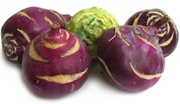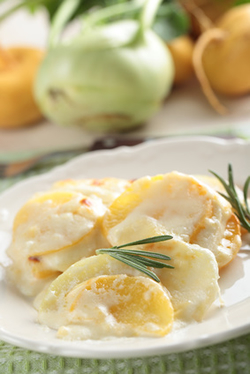Kohlrabi
Kohlrabi, also known as Cabbage Turnip, belongs to the cabbage family. It is recognizable by its round, swollen stem at the base of its leaves. There are both red and white (light green) varieties. Regardless of its outer color, the inside flesh of all kohlrabi varieties is pale green, slightly sweet, and crispy. The taste of kohlrabi is similar to broccoli stems or cabbage heart, but sweeter.
Kohlrabi originated in northern Europe. It was first developed by crossing wild cabbage with white beets or turnips. It grew in popularity in Europe in the 16th century and was first introduced to Germany in 1558.
Today, Germany is the world's largest kohlrabi producer and consumer. Annually, Germany produces 40,000 tons of kohlrabi, as well as imports kohlrabi from Holland, Italy, and other neighboring countries, to meet its annual consumption demand. Throughout Europe and around the globe, kohlrabi is considered a typical German vegetable.
Preparing Kohlrabi
Kohlrabi goes very well with roasts, steaks, Schnitzel, poultry, fish, and egg-dishes.
Start by giving the kohlrabi a good wash with warm water. After that, peel the kohlrabi. Younger kohlrabi tend to have a thinner skin so only a thin layer needs to be peeled. More mature kohlrabi has a thicker skin that must be peeled off. Cut off the bottom root-base and remove any leaves. Also remove any part that has become woody. If you are cooking the kohlrabi, you can also peel it after it is cooked to preserve as much as the nutrients as possible.
Kohlrabi can be eaten raw or cooked. Raw kohlrabi is delicious and refreshing shredded with a vinaigrette dressing or added to a salad. For best results, choose small, young kohlrabi if using it raw.
Kohlrabi can be boiled, steamed, baked, and filled. If boiling the kohlrabi, cook for 20-30 minutes (depending on size) for whole kohlrabi and 10-15 minutes for sliced kohlrabi.
Kohlrabi leaves are also edible and very high in nutrients. Chop them up and add them to salads. They can also be cooked. Briefly sautee them in some butter and lemon juice as you would spinach.
Nutritional Information
Kohlrabi is a low-calorie and nutrient-rich vegetable. 3.5 ounces (100g) of raw kohlrabi contains:
| |
|
| 30 calories |
91g Water |
| 6.2g Carbohydrates |
62mg Vitamin C |
| 2.6g Sugars |
390mg Potassium |
| 3.6g Dietary Fiber |
75mg Calcium |
| 0.1g Fat |
50mg Phosphorus |
| 1.7g Protein |
|
Kohlrabi also contains magnesium, iron, folic acid, and vitamins B1, B2, and B6. Most often only the round part of the stems are eaten. However, the leaves contain 3 times the amount of vitamins as the stem.
Selecting Kohlrabi
The key to delicious kohlrabi is its freshness and size. You can recognize the freshness of the kohlrabi by crisp, strong, bright leaves. The stem should be uniform in color and show no splits or bruises. Also, stay away from very large kohlrabi because these tend to be woody. Instead, choose smaller ones.

Photo: © eAlisa - Fotolia.com |
|
| |
|
There are both red and white (light green) varieties of the kohlrabi. White ones are generally grown in greenhouses, whereas the red ones are grown naturally outdoors. White varieties tend to be softer and milder in taste. Red varieties tend to be larger, tougher, stronger in aroma, and woody.
Storing Kohlrabi
Kohlrabi should be stored in a cold and moist location to prevent it from becoming woody. Kohlrabi can be stored in the refrigerator for one week. To store it longer, wrap the kohlrabi in a moist towel - they will then stay fresh for up to two weeks. Keep in mind that the longer kohlrabi is stored the more woody it tends to become.
Remove the leaves before storing the kohlrabi. If you are going to keep the leaves, store them in the refrigerator in a plastic bag for a maximum of two days.
Kohlrabi can be frozen for up to nine months. It is, however, best to blanch the kohlrabi (sliced or halved) for 3 minutes before freezing. This helps keep the structure and color of the kohlrabi in tact.
|

Photo: © Miroslav Beneda - Fotolia.com

Photo: © HLPhoto - Fotolia.com
|

